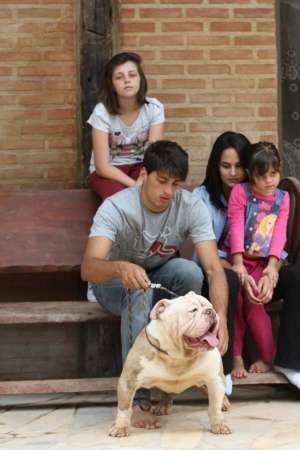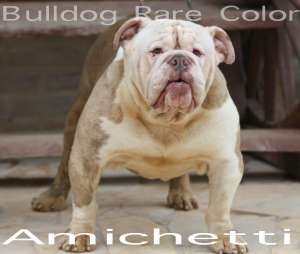TRICOLOR BULLDOG GENE MUSCLE BULLY
Amichetti Kennel
English Bulldog puppies for sale for you and your family. His knowledge of the Bulldog breed is second to none and his family, just like ours, has truly dedicated their lives to improving and breeding high quality bulldogs. If you have any questions or conerns, please don't hesitate to ask.
TRICOLOR BULLDOG GENE MUSCLE BULLY
you'll find the perfect  English Bulldog puppies for sale for you and your family. His knowledge of the Bulldog breed is second to none and his family, just like ours, has truly dedicated their lives to improving and breeding high quality bulldogs. If you have any questions or conerns, please don't hesitate to ask.
English Bulldog puppies for sale for you and your family. His knowledge of the Bulldog breed is second to none and his family, just like ours, has truly dedicated their lives to improving and breeding high quality bulldogs. If you have any questions or conerns, please don't hesitate to ask.
TRICOLOR BULLDOG GENE MUSCLE BULLY
Amichetti Kennel
Facebookhttps://www.facebook.com/profile.php?id=100006118369229
Youtube https://www.youtube.com/channel/UCWTOIIFQdl7oSCLpZJWaDjA
Contato info@petclube.com.br / amichettibully@gmail.com
Google+https://plus.google.com/u/0/+ClaudioAmichettiPetclube
whatssapp 11 99386-8744 hc Amichetti / 11 96393-1128 hc Dr. Gabriel
Google https://plus.google.com/u/0/collection/cSD0CB
Blog petclube-amichetti.blogspot.com.br/p/american-bully-pitbull-pocket-blue-nose_19.html
Amichetti Kennel
THANKS FOR STOPPING BY AND ADMIRING OUR BULLIES. WE ARE A BIG FAMILY BREEDER LOCATED IN SÃO PAULO BRASIL WHO OWN AND BREED ENGLISH BULLDOGS.
EVEN THOUGH WE SPECIALIZE IN RARE COLOR BULLDOGS; INCLUDING BLACK TRI BULLDOGS , BLUE TRI BULLDOGS, LILAC BULLDOGS AND CHOCOLATE BULLDOGS, WE DO NOT SACRIFICE THE QUALITY, HEALTH OR CONFORMATION OF THE BULLDOG BREED TO OBTAIN THESE RARE COLORS.OUR BULLIES HAVE OUTSTANDING TEMPERMENTS. WE HAVE YOUNG CHILDREN WHO CAN PLAY WITH OUR DOGS WITHOUT ANY FEAR OF AGGRESSION. OUR BULLIES, JUST LIKE OUR PUPPIES, ARE AROUND CHILDREN FROM THEIR FIRST DAY IN OUR HOME. SOCIALIZATION IS A KEY COMPONENT FOR A GENTLE DISPOSITION. VISIT OUR "PHOTO FUN" PAGE TO SHARE IN THE INTERACTIONS BETWEEN OUR CHILDREN AND OUR BULLIES. WE DECIDED TO BREED OUR BULLIES SO OTHERS CAN HAVE THE OPPORTUNITY TO SHARE THEIR LIFE WITH A HEALTHY, LOVING AND GENTLE BULLDOG. HEALTH, TEMPERMENT AND STRUCTURE ARE THREE VITAL COMPONENTS WE STRIVE FOR IN OUR BREEDINGS. ALL OF OUR BULLIES RECEIVE ANNUAL PHYSICALS FROM OUR VET AND FOLLOW UP CARE THROUGHOUT THE YEAR AS NEEDED. WE DO NOT HAVE BULLIES WITH HEALTH PROBLEMS IN OUR BREEDING PROGRAM. IF A GENETIC PROBLEM ARISES, THE BULLIE IS SPAYED/NEUTERED AND PLACED IN A COMPANION HOME. VISIT OUR "FOR SALE" PAGE FOR PUPPIES AND/OR OCCASIONAL ADULTS LOOKING FOR A HOME FOR KEEPS. WE PREFER TO SELL OUR BULLIES TO COMPANION HOMES BUT DO OCCASIONALY SELL TO ETHICAL BREEDERS. IF YOU HAVE ANY QUESTIONS ABOUT ANY OF OUR MALE OR FEMALE BULLIES, DON'T HESITATE TO GIVE US A CALL OR SHOOT US AN E-MAIL.
Geno=gene (deals with what the dogs actual genes look like), pheno (P is for picture, deals with what the dog physically looks like, the physical picture of the dog). You can also consider genotype is what is on the inside, phenotype is what is on the outside. There are several genetic locations (Loci) in which determine a dog’s color genetically. At each location, is a pair of genes (Alleles).
For Blue RARE English bulldogs puppies, the Loci, or location is called D for dilution. The possible alleles (or genes) at the D loci are “D” and “d”. Every dog is either “D-D”, “D-d”, or “d-d”. These are the genotypes. A genotype of “D-D” produces a pheontype of Non-dilute, or non-blue. The genotype “D-d” is what is typically called a “blue-carrier”. These dogs have a phenotype EXACTLY the same as “D-D”. They are NON-dilutes, and NON-blues. “D” is a dominant allele over “d” so only dogs which have a “d-d” genotype will have a blue or dilute phenotype. In other words, only “d-d” dogs are actually blue in color. Blue is a dilution which acts on black pigment as well as black colored hairs. Any pigment or hairs that would otherwise be black are diluted from black to blue on a “d-d” dog. This is what makes solid blue, blue brindle, blue fawn, blue pied, blue with tan points, blue masked fawn, blue sable fawn, and all other varieties of blue possible. D-d and d-d dogs can produce blue offspring. Any dog D-D, that is bred to a blue d-d, will produce an entire litter of D-d puppies, which are blue-carriers, but not blue. Each puppy inherits one gene from each parent.
The next Loci to talk about is K. At the K loci is where the determination is made for brindle or fawn. Possible alleles are K, Kbr, and k. K is dominant (solid black) kbr brindle and k fawn. We can simplify this loci to a basic dominant-recessive relationship (similar to blue or chocolate) with “kbr” (brindle) being dominant over “k” (fawn or non-brindle). “kbr-kbr” and “kbr-k” would be brindle, while only “k-k” would be fawn (or non-brindle). A Homozygous (which just means two of the same gene) brindle “kbr-kbr” would always produce brindle pups. This would be beneficial if one is trying to produce brindle-colored pups, or detrimental if one is trying to produce non-brindles. If the dog has just one K gene for solid black they will only be black with no other coloration with the exception of white like a black lab. K masks all other possible secondary colors in the phenotype but they ca be carriers for the genes on the a locus.
The A loci is the one responsible for the different variations of fawn and contributes to markings on tri dogs. Possible alleles are Ay, Aw, At, and a. Ay is dominant (solid) fawn. aw is for (wild or the wolf-type grey color) and is responsible for the sable in some fawns. at is responsible for tan points (black and tans). Lastly, a, is recessive black. For example; a blue tri bulldog would have to be kk (no dominant black “K” or brindle), at at for fawn points, and have the dd recessive. All the recessive genes must occur in this combination. A blue tri is a very rare color combination and much higher in price because the chances of having a blue tri dog are very slim!! Chocolate works in a similar way to blue as it is recessive. At the chocolate loci, B (I say B for brown) exists the two alleles “B” and “b”. Bulldogs can either be “BB” or “Bb” (non-chocolate). B is dominant to b so only those dogs with a “b-b” genotype will express the chocolate color. Chocolate is similar to a dilution as it acts upon black pigment making it brown. So the genotype of a chocolate dog is K,bb (self colored like a chocolate lab) or kk ,bb,Ay or kk,atat,bb (chocolate tri).
Chocolate works in a similar way to blue as it is recessive. At the chocolate loci, B (I say B for brown) exists the two alleles “B” and “b”. Bulldogs can either be “BB” or “Bb” (non-chocolate). B is dominant to b so only those dogs with a “b-b” genotype will express the chocolate color. Chocolate is similar to a dilution as it acts upon black pigment making it brown. So the genotype of a chocolate dog is K,bb (self colored like a chocolate lab) or kk ,bb,Ay or kk,atat,bb (chocolate tri).
The Lilac is the most misunderstood. Lilac RARE English bulldogs puppies are simply diluted chocolate. A lilac tri must be kk (non bindle), bb (brown causes black to be a brown or chocolate color), dd (dilution gene to get the light chocolate coloring. A lilac dog would have no black or grey hairs. The nose is chocolate and eyes are blue or hazel. I believe all the recessive genes in this combination are very very unlikely so I strongly recommend a DNA test be done before purchase.
The last loci to discuss is S, patches of white. This is where piebald markings come from. Alleles are S, si, sp, and sw. S is dominant for self-colored (can have white chest or toes – under 10 percent white). The si is for Irish spotting, which usually is white chest, lower legs, undersides, white collar, white blaze and can be 10-30 percent white. The sp allele is for the typical piebald, which is random spots of color can be 20-80 percent white and is usually non-symmetrical. The sw allele is for extreme white. Any combination of the recessive genes white genes creates the degree of white marking.
I would be happy to evaluate the possible genetic make up of your old English bulldogs puppies based on my experience, education, and research. Let me know if I can help you understand the color genetics of the bulldog. I appreciate any comments and contributions on this issue.